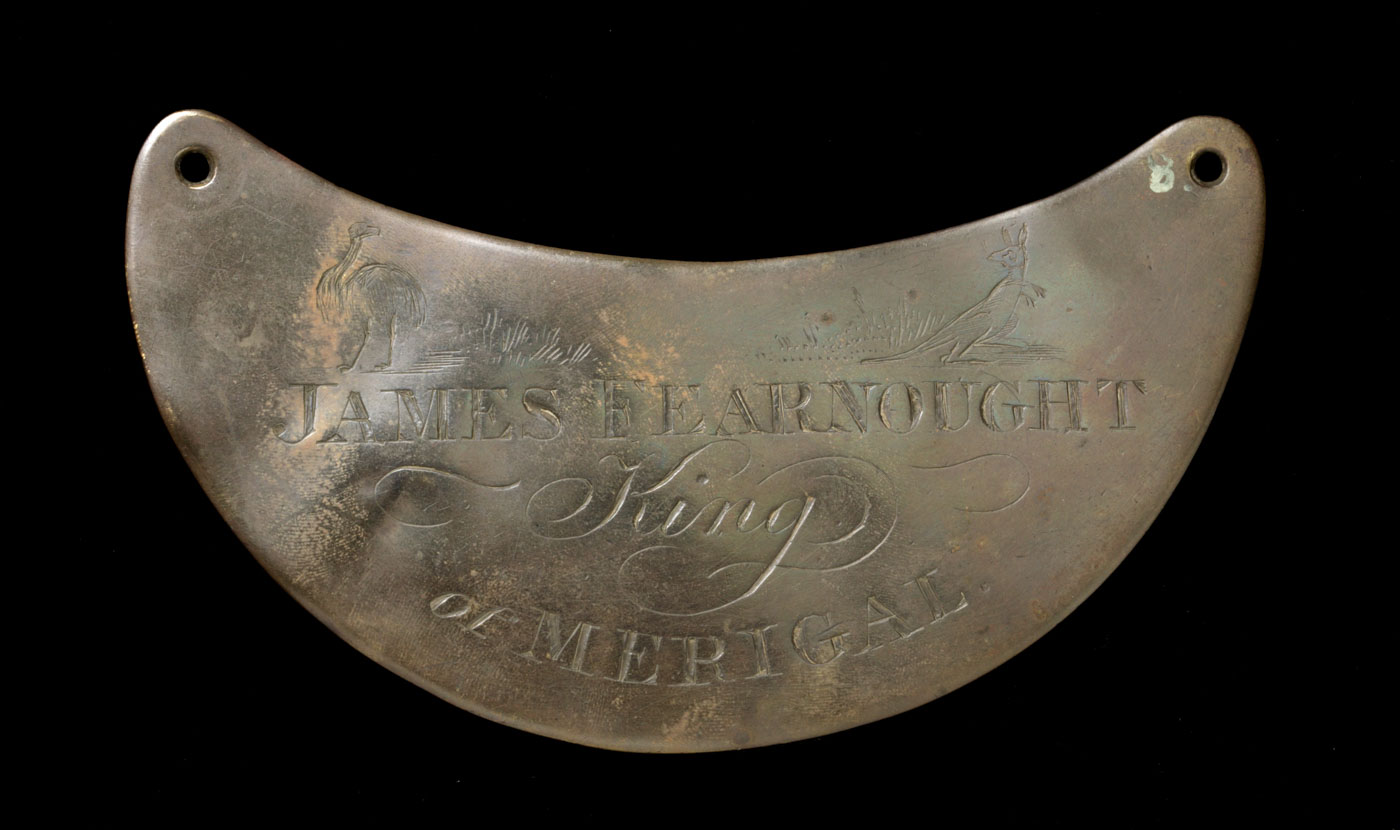King of Merigal
Both the shape and manufacture of this gorget are unusual among those in the Museum’s collection. It is a particularly shallow crescent shape and the plate is very thin sawn and beaten brass.
The lettering of the inscription is a little rough, but its accurate placement and the balance of design suggest it was the work of a professional engraver.
The decoration is the popular emu and kangaroo. The surface patina of the gorget is particularly smooth and although the suspension holes are only slightly worn the lightness of the plate would not put much strain on them. Evidence collected by Edmund Milne suggests a date of about 1850 for the gorget which is reinforced by the style of lettering and design.
In 1912 Milne was able to obtain some information about James Fearnought and his son Michael via two letters from John Jones whose grandfather gave James the gorget. The name Fearnought was probably given to James in honour of his reputation as ‘a great fighter’.
Yours to hand re ‘James Fearnot’ the plate you refer to as given to him by the late Alexander McGregor (my grandfather) I can only remember seeing the black fellow once or twice, he was a tall, thin man with a grey pointed beard. I can recollect his death clearly, as the blacks principally the gins went about with fire sticks and burnt green bushes, scorching anywhere they thought he had inhabited and walked. ... I cannot find out how long ago it was since his death or how long he reigned as ’King of Merigal nor the size of territory he reigned over. He had one son ‘Michael’ who was always known as ‘Merigal Mick’ he was also presented with a brass plate with ‘Michael Fearnot’ King of Merigal inscribed on it, he never wore it and did not take up the duties of ‘king’ as his father before him had done and who was very proud of the plate ... I will make enquiries from my mother who will know more about him as she was on the Station at the time. ... He was buried about a mile away from Merigal Homestead, the tree which marked his grave has since been destroyed. [1]
Re the plate you have inscribed ‘James Fearnought’. My mother remembers him quite well. Her father James McGregor, have him the inscribed plate about 60 years ago. When she first knew him he was about 30, a tall fine built nigger. He died of consumption when he was about 50, made his headquarters at Merigal and his country was between the Macquarie and Castlereagh Rivers. He died at Merigal and was buried about three miles down the creek at a burying place the blacks had there. his first Gin, Mary Ann had one son, he traded or gave her to a white shepherd on Bullagreen, then part of Merigal — William Mahoney, and the son Micky, aged about six went with her. His second Gin, Nellie, was much younger, and also had one son. When mother knew Jimmy, there was no fighting, but from his build she thinks he would have been a great fighter. He mostly was at Merigal alone with his Gin, but Mother says she has seen as many as one hundred blacks there with him. [2]
Footnotes
[1] J Jones, Letter from J Jones, Hotel Metropole, Sydney, 22 February 1912 to E Milne Esq., District Superintendent, Orange, manuscript, National Museum of Australia, 1912, EO Milne collection, file no 85/310, folios 152–53.
[2] J Jones, Letter from John Jones per A D, Hotel Metropole, Sydney, 20 March 1912 to Milne Esq., District Superintendent of Line, Orange, manuscript, National Museum of Australia, 1912, EO Milne collection, file no 85/310, folio 151.
